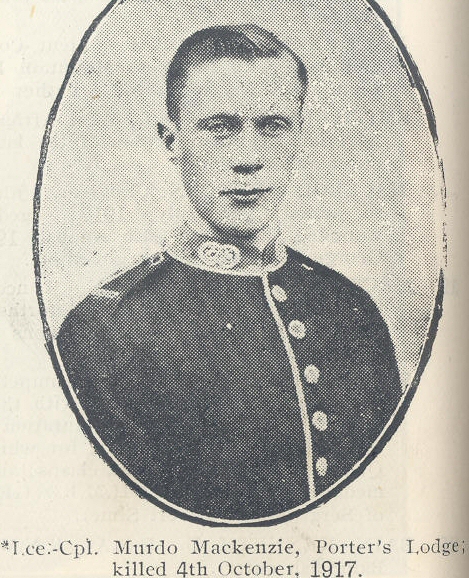
Lance Corporal MURDO MACKENZIE
Last address in Lewis: 49 Balallan
Son of Malcolm and Catherine Mackenzie,
Husband of Mary J Kennedy of Glasgow
Service unit: 2nd Seaforth Highlanders
Service number: 204319, previously 6203 Argyll & Sutherland Highlanders
Enlisted at Stornoway
Date of birth: 4 May 1894
Date of death: 4 October 1917 at the age of 23
Killed in action
Memorial: Tyne Cot Memorial, Panel 132 to 135 and 162A.
Local memorial: Kinloch, Laxay; Lewis War Memorial; Nicolson Institute WW1, middle panel
Also quoted at Porter's Lodge, Stornoway
Murdo was the second son of Malcolm (1858) and Catherine (1852), the other being Malcolm (1890); a third child died in infancy.
From the 2nd Seaforth Highlanders' war diary
The battalion is in action east of Ypres, conducting the battle of Broodseinde, the last battle of Passchendaele.
The Battalion formed up for attack by zero -1 hour on correct alignment in touch with 1st Hampshire on right and R Dublin Fusiliers on left. Coys were closed up to total depth of 120 yards to get clear of EAGLE trench which would have broken formations. Two leading platoons of each assaulting coy carried trench boards in cue of difficulty being found in crossing water and marsh between starting point and KANGAROO trench and LAUDETBEEK. Platoons were to advance in succession under cover of the creeping barrage at correct distances of 100yards between platoons and 150 yards between coys with moppers coy HQs 50 yards in rear of the platoon of each coy.
At zero hour (6 am) leading platoons advanced into barrage, but found great difficulty in keeping alignment owin to water forcing them to follow best ground or the marsh. This caused confusion and resulted in formation of assaulting coys being lost, especially on left where the leading wave walked into our own barrage. KANGAROO trench was reached without coys, platoons being able to disentangle themselves enemy who showed resistance being bayonetted and remainder being passed back. A total of about 25 men were taken prisoner on the front up to KANGAROO trench, including several men were killed by enemy barrage fire on their way back. The left assaulting coy came into some resistance and did not take many prisoners. Coy SM Bain killing 15 enemy to his own bayonet. As the advance proceeded coys endeavoured to regain formation but this was found to be impossible owing to confusion and the excited condition of the men. Up to BEEK STREET trench casualties were not heavy, but from that point onwards machine gun fire was encountered, from left flank generally and this fire caused considerable casualties, both coy commanders and 6 of their platoon commanders of the two left coys being put out of action. Continuing their advance towards their objective, the left coy captured the fortified houses and the right coy advance over 19 Metre Hill. The left coys were unable to advance further, where the remaining men established themselves in shell holes.
Stornoway Gazette
Lance-Corporal Murdo Mackenzie, Seaforth Highlanders, only son of Mr and Mrs Mackenzie, Porter's Lodge, Stornoway, was killed in action in France on 4th October 1917. Lance-Corpl Mackenzie was in the Regular Army and some months before the outbreak of war had been "bought out" by his parents. He returned home and for a couple of years was on the Police Force in Stornoway. He enrolled under the Derby Scheme, but was rejected on medical grounds. In December 1915, he left Lewis and went to Glasgow, where he got married. In November 1914, he was called up, and drafted into the Argyll & Sutherland Highlanders, but was afterwards transferred to his old regiment, the Seaforths. He was a crack shot, and at Ripon was presented with a souvenir by his Commanding Officer for putting up the best score registered in the musketry practice carried on there since the war started. He was also an enthusiastic piper, and was a great favourite with all his companions. For his sorrowing parents, widow and child, sincere sympathy is felt. The Captain of his Company, writing to Mrs Mackenzie says:
"I am writing to give you the few details I knew about your husband who was killed on 4th October, 1917. The Battalion attacked in the morning of the 4th and gained all their objectives. Your husband was all right until the afternoon, when a German sniper saw him and shot him through the head. Death was instantaneous. He never moved again. I cannot say with absolute certainty where he was buried as the Battalion came out that night, and had only time to get the wounded back, but since then we have gained more ground and the spot where your husband fell is now well behind the firing line, so his body must have been recovered and buried by some other unit. It was just south of Poelskapelle, which itself is NE of Ypres. I cannot tell you how sorry I was to hear about your husband. He was such a good soldier and an extra-ordinarily charming man. His section worshipped him and would have done anything for him. I can understand only too well how deep your grief wmust be, for I knew what he was to his friends, and how much more he must have been to his wife. I am afraid there is very little I can say or do to help you in your great grief, but I feel sure that the thought that he died in the way that he himself would have chosen will in some small part soften the blow."
No comments:
Post a Comment